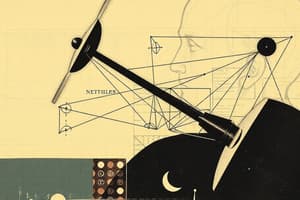Podcast
Questions and Answers
What does Newton's first law imply about the necessity of a force to change the state of motion of an object?
What does Newton's first law imply about the necessity of a force to change the state of motion of an object?
An object will not change its state of motion unless acted upon by an unbalanced force.
How does Newton's second law mathematically express the relationship between net force, mass, and acceleration?
How does Newton's second law mathematically express the relationship between net force, mass, and acceleration?
It states that acceleration is equal to the net force divided by mass, or $a = \frac{F_{net}}{m}$.
What is the significance of the Heisenberg uncertainty principle in quantum mechanics?
What is the significance of the Heisenberg uncertainty principle in quantum mechanics?
It states that one cannot simultaneously know the exact position and momentum of a particle.
Explain the concept of wave-particle duality and its implications for quantum systems.
Explain the concept of wave-particle duality and its implications for quantum systems.
How is the concept of work defined in classical mechanics?
How is the concept of work defined in classical mechanics?
What role does the zeroth law of thermodynamics play in the establishment of thermal equilibrium?
What role does the zeroth law of thermodynamics play in the establishment of thermal equilibrium?
Discuss the concept of superposition in quantum mechanics.
Discuss the concept of superposition in quantum mechanics.
What are the practical applications of classical mechanics in engineering?
What are the practical applications of classical mechanics in engineering?
Explain how the first law of thermodynamics relates to spontaneous processes in thermodynamic systems.
Explain how the first law of thermodynamics relates to spontaneous processes in thermodynamic systems.
What are the implications of special relativity on the concepts of time and space for observers moving at different velocities?
What are the implications of special relativity on the concepts of time and space for observers moving at different velocities?
Describe the role of Maxwell's equations in understanding electromagnetism.
Describe the role of Maxwell's equations in understanding electromagnetism.
In what way does the third law of thermodynamics define absolute zero, and why is it significant?
In what way does the third law of thermodynamics define absolute zero, and why is it significant?
Analyze how diffraction differs from reflection and refraction in the study of optics.
Analyze how diffraction differs from reflection and refraction in the study of optics.
How does general relativity expand upon the concepts introduced in special relativity?
How does general relativity expand upon the concepts introduced in special relativity?
Discuss the interaction between electric charges and magnetic fields as described in electromagnetism.
Discuss the interaction between electric charges and magnetic fields as described in electromagnetism.
Evaluate the significance of entropy in determining spontaneous processes according to the second law of thermodynamics.
Evaluate the significance of entropy in determining spontaneous processes according to the second law of thermodynamics.
Flashcards
Classical Mechanics
Classical Mechanics
Describes how macroscopic objects move. Based on Newton's three laws of motion.
Newton's First Law
Newton's First Law
An object at rest stays at rest, and an object in motion continues at a constant velocity unless acted upon by a net force.
Newton's Second Law
Newton's Second Law
Acceleration is proportional to the net force acting on an object and inversely proportional to its mass. F = ma.
Newton's Third Law
Newton's Third Law
Signup and view all the flashcards
Inertia
Inertia
Signup and view all the flashcards
Quantum Mechanics
Quantum Mechanics
Signup and view all the flashcards
Quantization of Energy
Quantization of Energy
Signup and view all the flashcards
Thermodynamics
Thermodynamics
Signup and view all the flashcards
What is the first law of thermodynamics?
What is the first law of thermodynamics?
Signup and view all the flashcards
What does the second law of thermodynamics tell us?
What does the second law of thermodynamics tell us?
Signup and view all the flashcards
What does the third law of thermodynamics define?
What does the third law of thermodynamics define?
Signup and view all the flashcards
What is electromagnetism?
What is electromagnetism?
Signup and view all the flashcards
How do electric and magnetic fields interact with charged particles?
How do electric and magnetic fields interact with charged particles?
Signup and view all the flashcards
What is special relativity?
What is special relativity?
Signup and view all the flashcards
What is general relativity?
What is general relativity?
Signup and view all the flashcards
What are the key concepts in optics?
What are the key concepts in optics?
Signup and view all the flashcards
Study Notes
Classical Mechanics
- Classical mechanics describes the motion of macroscopic objects.
- It is based on Newton's laws of motion.
- These laws describe the relationship between forces acting on an object and its motion.
- Newton's first law states that an object at rest stays at rest and an object in motion stays in motion with the same speed and in the same direction unless acted upon by an unbalanced force.
- Newton's second law states that the acceleration of an object is directly proportional to the net force acting on it and inversely proportional to its mass.
- Newton's third law states that for every action, there is an equal and opposite reaction.
- Key concepts include inertia, mass, force, momentum, and energy.
- Applications of classical mechanics are widespread, including in engineering, astronomy, and everyday life.
- Common problems solved using classical mechanics could include: Calculating projectile motion, analyzing the motion of a pendulum, or determining the forces involved in collisions.
- The concept of work is central to classical mechanics.
- Work is the transfer of energy by a force acting on an object as it moves.
- The concept of energy is fundamental to classical mechanics.
Quantum Mechanics
- Quantum mechanics describes the behavior of matter and energy at the atomic and subatomic levels.
- It introduces significant departures from classical mechanics.
- Key concepts include quantization of energy, wave-particle duality, uncertainty principle, and superposition.
- Quantization of energy means that energy can only exist at discrete values.
- Wave-particle duality implies that particles can exhibit both wave-like and particle-like properties.
- The Heisenberg uncertainty principle states that it is impossible to simultaneously know both the position and momentum of a particle with perfect accuracy.
- Superposition means that a quantum system can exist in multiple states simultaneously until measured.
- Quantum mechanics is used to understand and predict the behavior of atoms, molecules, and other quantum systems.
- It has numerous applications, including in the development of lasers, transistors, and nuclear power.
Thermodynamics
- Thermodynamics deals with heat and energy and their relationship to macroscopic systems.
- Four laws govern thermodynamic systems.
- The zeroth law states that if two thermodynamic systems are each in thermal equilibrium with a third, then they are in thermal equilibrium with each other.
- The first law is a statement of energy conservation and applies to any thermodynamic process.
- The second law identifies the direction of spontaneous processes and deals with entropy.
- The third law defines absolute zero temperature.
- Thermodynamics plays an important role in understanding processes in chemistry, engineering, and many scientific fields.
Electromagnetism
- Electromagnetism describes the interaction between electric charges and magnetic fields.
- Electric charges create electric fields, and moving charges create magnetic fields.
- Electric and magnetic fields can exert forces on charged particles.
- Electromagnetic waves, such as light and radio waves, are produced by accelerating charged particles.
- Key concepts include electric charge, electric field, electric potential, magnetic field, and electromagnetic induction.
- Maxwell's equations describe the fundamental principles of electromagnetism.
- Applications of electromagnetism are extensive in many technologies, from power generation to communications.
Relativity
- Relativity encompasses two theories: special relativity and general relativity.
- Special relativity deals with the relationship between space and time for observers moving at constant velocities relative to each other.
- It postulates the constancy of the speed of light and profound implications on length contraction and time dilation.
- General relativity extends special relativity to include gravitational fields.
- It describes gravity as a curvature of spacetime caused by mass and energy.
- It leads to predictions that differ significantly from Newtonian gravity, particularly in extreme gravitational fields.
- Relativity has been experimentally verified and is crucial in understanding phenomena like black holes and the universe’s large scale structure.
Optics
- Optics is the study of light and its behavior.
- It involves the interaction of light with matter.
- Key concepts in optics include reflection, refraction, and diffraction.
- Reflection is the bouncing of light off a surface.
- Refraction is the bending of light as it passes from one medium to another.
- Diffraction is the spreading of light as it passes through an aperture or around an obstacle.
- Optics has applications in optical instruments like microscopes, telescopes, and cameras.
Studying That Suits You
Use AI to generate personalized quizzes and flashcards to suit your learning preferences.




